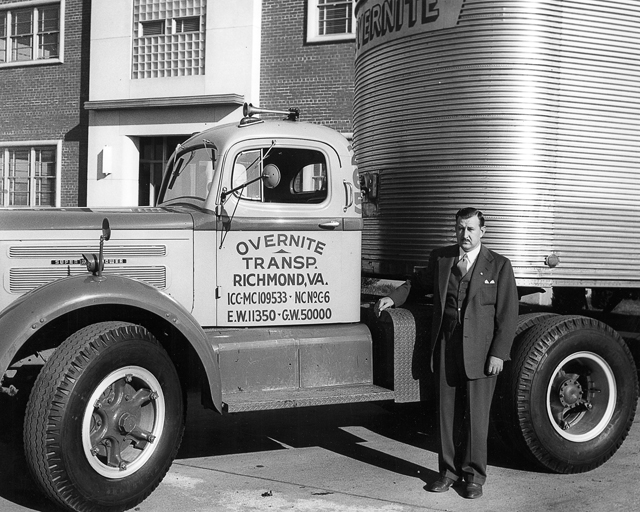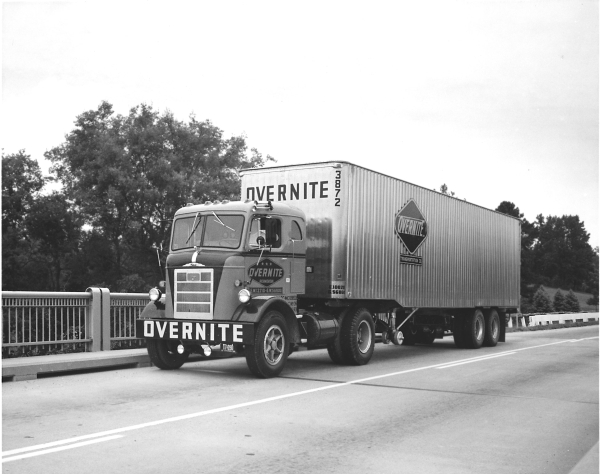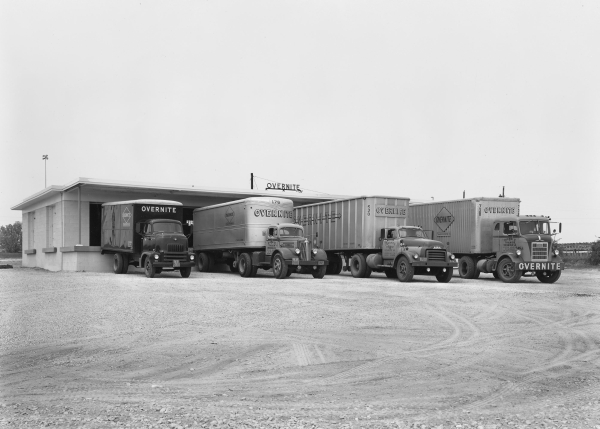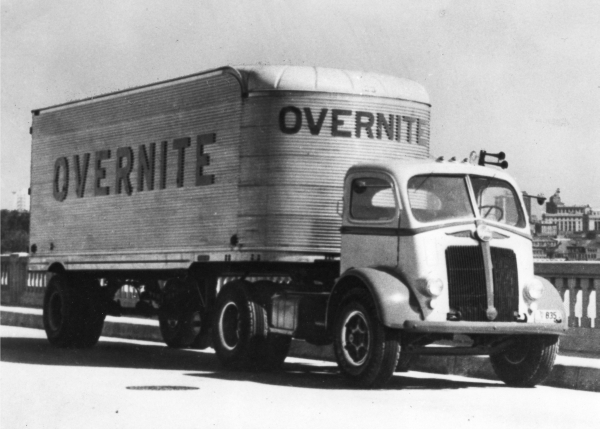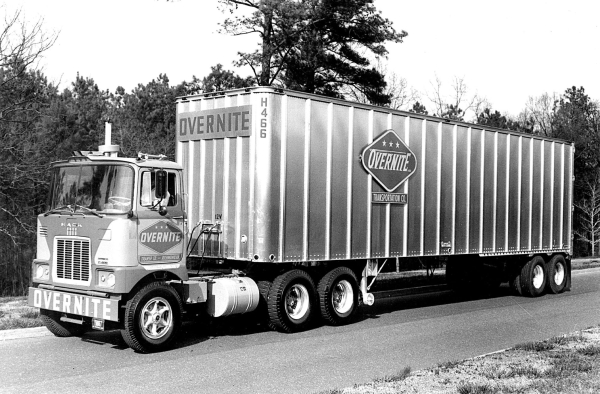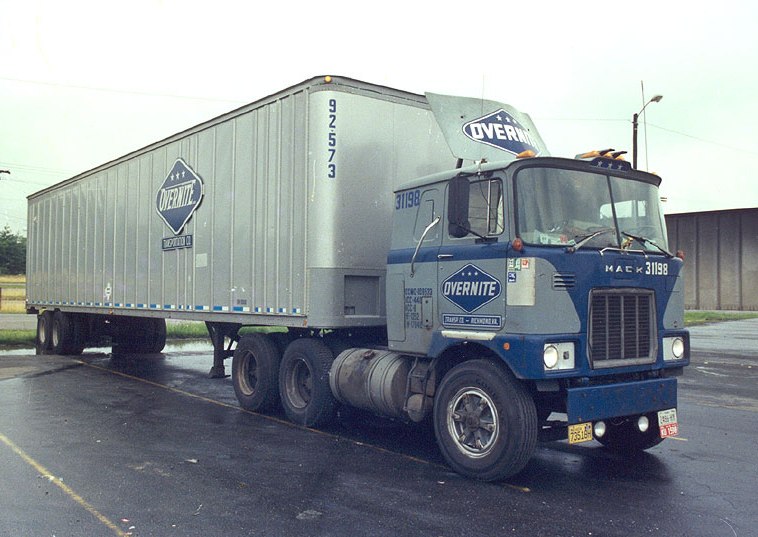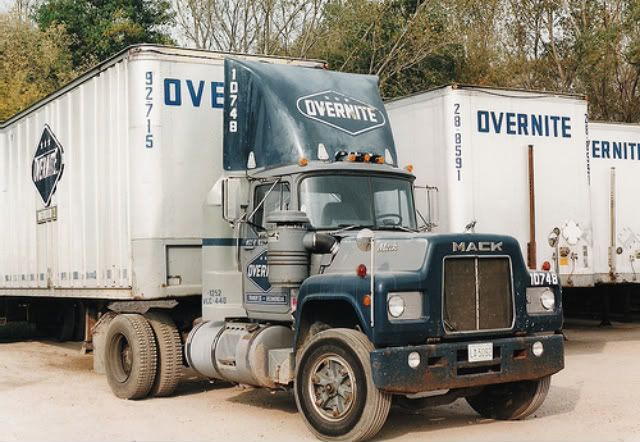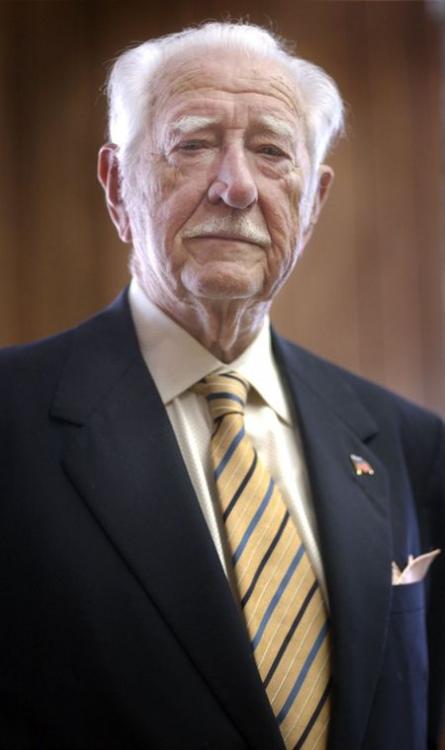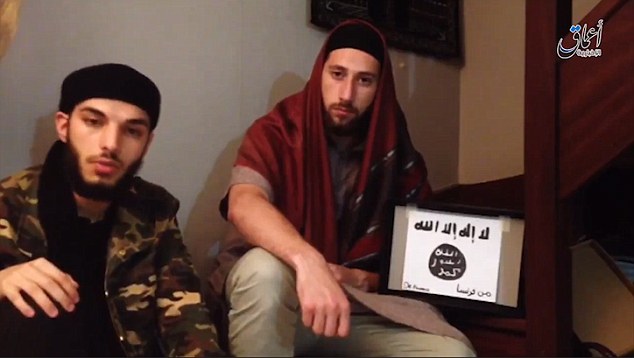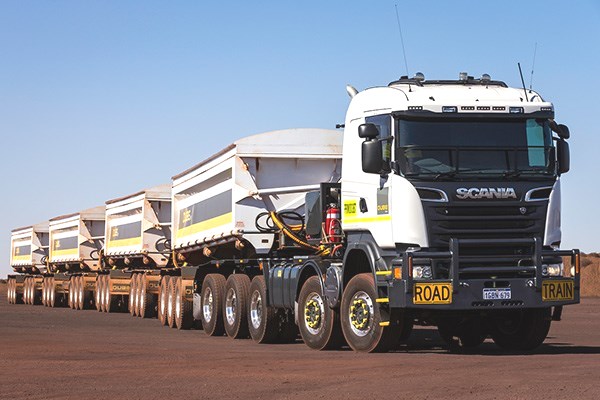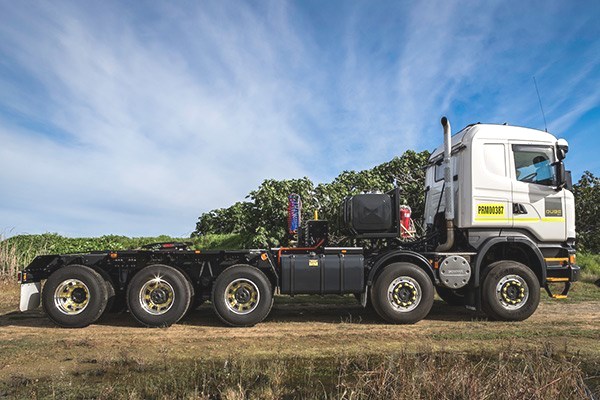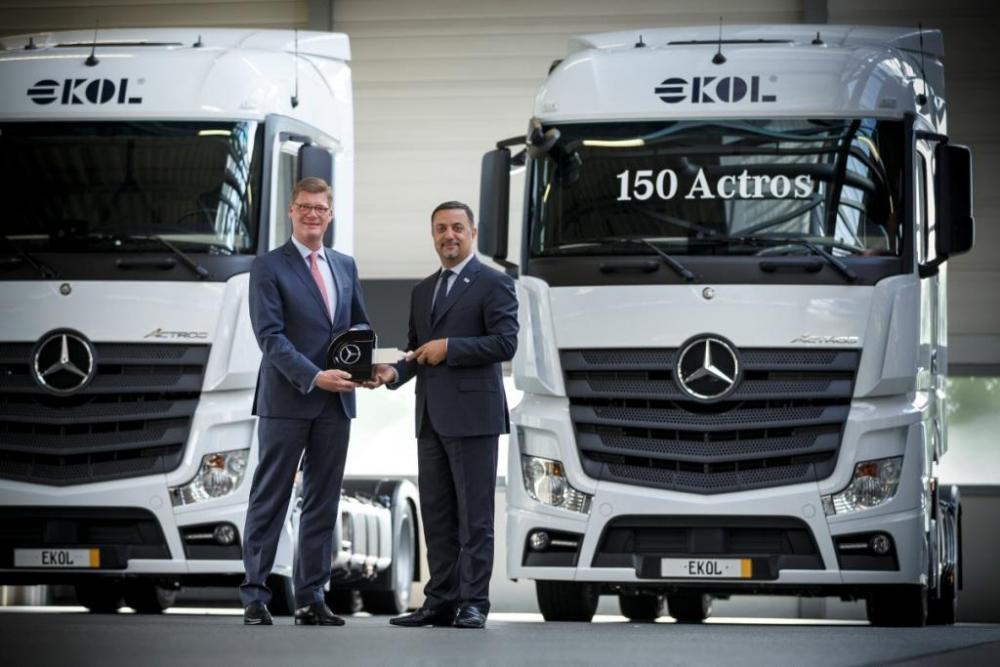
kscarbel2
Moderator-
Posts
18,855 -
Joined
-
Days Won
114
Content Type
Profiles
Forums
Gallery
Events
Blogs
BMT Wiki
Collections
Store
Everything posted by kscarbel2
-
Overnite Transportation Founder Cochrane, 97, Still Consulted Frequently for His Sage Advice Transport Topics / September 13, 2010 RICHMOND, Va. — People in trucking have long viewed themselves as a collection of hardworking individuals — and there are plenty of stories to support that belief. But who among them has worked harder and longer than J. Harwood Cochrane, founder of the highly successful Overnite Transportation Co. at age 22 and the more middling Highway Express at age 78? What soul singer James Brown was to show business, Cochrane has been to trucking — the hardest working man in the industry. Cochrane will turn 98 in November and walks with the assistance of a cane after he broke a hip earlier this year. But he still follows trucking from his spacious apartment in a well-heeled retirement community here, ponders mergers and acquisitions, and offers advice to the president of UPS Freight, Overnite’s successor, at a monthly lunch. “He’s probably the greatest LTL trucker of us all,” said Earl Congdon, chairman of Old Dominion Freight Line, Thomasville, N.C. “I used Overnite as a pattern for Old Dominion. We tried to do the same thing, but we were 15 to 20 years behind him.” Cochrane is a thrifty — some say, cheap — man, who grew up in rural poverty, left high school without graduating so he could work, started a business during the Great Depression that is still around, amassed a nine-figure fortune and now has given most of it away to finance causes ranging from the Virginia Museum of Fine Arts to wells that provide drinking water for poor African villages. His first power unit in freight transportation had just one horsepower, and that horse’s name was Charlie. He pulled Cochrane’s Virginia Dairy milk wagon through the streets of Richmond, the state’s capital city. Early on, Cochrane drove poor-quality trucks because, he said, he couldn’t afford premium vehicles. He slept in his sleeperless cab, curled up with an oil heater for warmth. Later, he pushed for standardization in tractor and trailer design. He took Overnite public in 1957 and led it onto the New York Stock Exchange five years later. He spent years fighting off Teamsters organizing campaigns and collected judgments against the union. He sold Overnite, a less-than-truckload carrier, to railroad holding company Union Pacific Corp. in 1986 for $1.2 billion. His truckload venture, Highway Express, didn’t work as well. But when he sold it to Celadon Group in 2003 at age 91, he still had to sign a five-year noncompete agreement. Cochrane follows trucking and tends to his investments with the help of Nancy Earnhardt, his now part-time secretary, who has worked for him for 52 years. “I did everything wrong. I bought the wrong trucks, the wrong tires and trailers. I survived on determination and hard work,” Cochrane said as he reviewed his career during a recent interview here. He seems to have learned from his mistakes, though, and the industry’s events have kept his mind active for roughly 80 years. “I dream of mergers at night,” Cochrane said, adding that he doesn’t want to engineer them but that he naturally tends to speculate on the subject after having pulled off 56 of them during his Overnite years. His current favorite idea involves three regional carriers, all based in the East, forming a triple combination. “Those three would make a perfect combination, although they’d have to close 50 to 70 terminals,” he said. He has long thought LTL consolidation will continue, he said, until there are only about eight very large carriers left. Looking at other operations, Cochrane said he thinks Congdon’s Old Dominion is “well run.” On the truckload side, he also respects Heartland Express’ operations but wonders why the stock hasn’t done better lately, especially because Knight Transportation has. Cochrane’s heart may be in trucking, but as an investor, his head is not. “I would choose another industry before trucking as an investor,” he said. “If the company isn’t union now, there’s the threat of it.” C.H. Robinson Worldwide, the nation’s largest freight broker, worries him as a trucker but intrigues him as an investor. “They really take a high percentage [of the freight bill as a fee], but I’m tempted to buy some stock.” He also said the Con-way Inc. model of offering large-scale LTL and truckload services has great merit because of the opportunity to cross-sell to a single customer base. “The two services fit together quite nicely,” he said. “The first official action I took,” said UPS Freight President Jack Holmes, who has had the job as Cochrane’s successor since 2007, “was to establish a UPS Freight Leadership Hall of Fame. We inducted Leo Suggs, Gordon Mackenzie and Mr. Cochrane.” Suggs ran Overnite from 1996 to 2006, and Mackenzie was in charge between Suggs and Holmes, in 2006-07. It was Cochrane’s second Hall of Fame appearance. He was inducted into the Automotive Hall of Fame in Dearborn, Mich., in 1991. After Cochrane sold his ownership stake to the railroad in 1986, he stayed for four more years as a hired manager. His immediate successor, Union Pacific executive Thomas Boswell, did not get along with him. “He disliked me with a passion,” Cochrane said. Boswell asked him to leave in 1990, and Cochrane did. The next year, he started truckload carrier Highway Express. He ran that business for a dozen years until he sold it to Celadon. “I thought I had lost money on it, but after the final tax return was done, I found that I’d made $2 million. That wasn’t much money relative to all of the revenue involved, but it was nice to know that I didn’t lose anything,” Cochrane recalled. Holmes said the railroad removed Cochrane’s portrait from the lobby of the company’s headquarters here, “but I put it back up.” Holmes said he has been talking to Cochrane regularly since 2008, and it’s not just to be polite to an old man. “As it became obvious the economy was suffering and slipping away in 2008, I had to figure out what would be our approach,” Holmes said. “Harwood Cochrane was the only guy I knew who managed an LTL company through a worse economy. He survived the Great Depression. “He told me, ‘You have to count every nickel,’ and take control of the expense side. If you don’t take expenses down, he said, the customers will get caught in the middle as the revenue drops.” “I’ve got very selfish reasons for meeting with him,” Holmes said. In 1989, Overnite published a biography of Cochrane that tells his life story through the Union Pacific sale. Estelle Sharpe Jackson, who wrote about Cochrane for Virginia Business magazine, provides a useful chronology of his life and some compelling anecdotes. Cochrane had six siblings who survived to adulthood. For much of his childhood, their mother stayed with the children on a farm outside of town while Cochrane’s father worked construction in Michigan and sent back money. The elder Cochrane died at age 56, when Harwood was 16, shortly before the Depression started. The first job that he liked was the dairy job, but that was just his day job, according to Jackson’s “Mr. Cochrane’s Overnite.” He and his brother Calvin started Cochrane Transportation in 1933 to move furniture, groups of people and anything else around town. Success in trucking was not inevitable for the family. The brothers split at the end of 1934, with Harwood starting Overnite in January 1935 and Calvin keeping the name Cochrane Transportation. The two brothers did not want to compete with each other, Harwood Cochrane said, so he hauled freight in Virginia and North Carolina with nonunion labor, whereas Calvin looked north toward Washington, Baltimore and Philadelphia and worked with unionized employees. Calvin Cochrane’s company went out of business before 1940, however, and he returned to farming for a living. Harwood Cochrane said he got his first big break after the 1941 attack on Pearl Harbor, Hawaii. In 1942, he began hauling freight for the Marine Corps from Philadelphia to North Carolina. It was lots of steady business. The other work that helped to stabilize Overnite in the 1940s and made it profitable and durable was hauling cigarettes, Cochrane said. Philip Morris Inc. and R.J. Reynolds Tobacco Co. were both frequent sources of freight. Casting about carefully for the right word, Old Dominion’s Congdon called Cochrane “thrifty.” Others, speaking on the condition of anonymity, went straight for “cheap.” Congdon said Cochrane, like most businessmen in the 1950s, did not like the Korean War-era tax that collected 90% of profits and left only one dime out of every dollar with companies. “A White Trucks dealer was trying to sell him trucks and emphasized that point,” said Congdon. “Harwood replied, ‘Yes, but I want that dime.’ He was a light tipper. He’d tip 10% when I tipped 15%. But he was also a philanthropist who gave away much of his fortune.” Cochrane saw enough of life’s difficulties, even at an early age, to know that nothing was easy. There was the poverty of his youth, even before his father died and the Depression started. There was Calvin’s business failure in trucking. LTL carriers started folding in large numbers in the 1980s because they could not adjust to deregulation. Cochrane bought some of their signs and fastened them to a wall at one of his terminals to remind employees that no one is ever completely safe. “Hundreds of days could have been my last ones in business,” Cochrane recalled. “I didn’t have money to pay bills.” He had to learn both ends of the business, finance and operations. He shopped carefully for terminals, often snapping up real estate from failed competitors in exchange for ready cash. “I always looked at what was available when a company went out of business,” he said. “When you’re going bankrupt, you want money right quick. I had lousy terminals to begin with and wanted better.” He also prized modern tractors and trailers with easily replaceable parts that could be operated efficiently. “I’ve seen changes of every size and shape,” he said. “Trailers weren’t easily interchanged when I started. There were different types of fifth wheels, and light connectors usually had to be cut and respliced. There were no uniform fifth wheels and light plugs.” Cochrane said one of the most important things he ever did for trucking was to get together with management from Yellow Freight System, Roadway Express, Consolidated Freightways and Carolina Freight to urge Fruehauf Trailers to manufacture a standard trailer that all of those carriers would buy. Cochrane’s committee gave detailed advice on landing gear, fifth wheels, king pins and electrical hookups. “We got to 97% of a trailer,” he said, before things fell apart, but the work was picked up by others and led to greater standardization. “It was a great service to the industry, I think.” As a result of his obsession over operational efficiency, Overnite was one of the industry’s most profitable carriers, often producing operating ratios — expenses as a percentage of revenue — in the 80s, which is considered a sterling measure of financial performance. An important part of the financial side for Cochrane was his strong bias against unionized labor. Having observed early on that life often can be difficult and that success is never guaranteed, Cochrane knew only one way to run his company: work fiendishly hard as much as you can; give customers whatever they want whenever you can; and make sure your employees work hard, too. A couple of incidents related to union work rules made up his mind. As related in Jackson’s biography and confirmed in an interview, Cochrane did sign a Teamsters contract in the 1940s because of the Southern Biscuit Co., a major shipper with unionized employees who wouldn’t tend to Cochrane’s trucks because his employees weren’t union members. Cochrane signed a labor contract, and shortly thereafter, a fight ensued. A local Teamsters leader wanted Cochrane to fire an executive, but Cochrane wouldn’t — because the man in question did not work for Overnite but for another company instead. Picketing and interruptions took place until Cochrane could prove the man worked elsewhere. “Afterward, they laughed and said I should forgive and forget. I told them I could forgive, but I’d never forget,” he said. Another time, he was delayed significantly while moving 3,700 pounds of freight at a newly purchased New Orleans terminal because the necessary employee for freight handling was not around and an available employee on site was not allowed to do that job, he said. Among Cochrane’s memorabilia are two photos of checks from 1963. One, for more than $359,000, was signed by Jimmy Hoffa, the late union president. The other is from liquidating a Teamsters union hall in Charlotte, N.C., to satisfy a judgment against the union in favor of Overnite. Cochrane said he is not happy that his old company now uses Teamsters union employees. He and Holmes talked about the 2008 switch to representation. Cochrane said he’s concerned that UPS Freight will not be as agile in serving customer needs. Holmes said UPS has been working with the Teamsters union for about 80 years on the package side and that UPS managers know how to work well with Teamsters employees. Cochrane didn’t just shut out the union by fiat. He convinced his employees to vote against representation elections by providing steady employment, encouraging employees to get their relatives to work for Overnite, providing a well-funded retirement fund, offering stock ownership to employees and taking an interest in their personal lives. “He engrained a culture into the organization that was family-oriented,” said Leo Suggs, the one-time Overnite boss and now chairman and CEO of Greatwide Logistics Services, Dallas. “After he left [in 1990], it was much less personal. He had the commitment of people in the organization . . . and it was a hardworking group.” Suggs said he took the lesson on corporate culture to heart and has tried to replicate it with Greatwide. He had not met Cochrane before becoming one of his successors, Suggs said, but he called him up and found him happy to talk. “He encouraged nepotism. He wanted employees to want their sons and daughters to work there,” Suggs said. “He viewed Overnite as his family, and it was the most successful trucking company in America when he sold it. He loved the company and its employees, and it was mutual. “He didn’t sit behind his desk in his office. He went out with drivers and dockworkers,” Suggs added. “He learned that mutual respect and a willingness to share was the road map for a successful company. If employees know they have job security and good equipment, they feel better and do more for customers. That makes for better business. It’s a full circle and he reinforced it.” Cochrane no longer has a company to run. With Earnhardt’s help, he tends to his investments and follows events in trucking. Despite difficulty with his hip, he feeds the ducks at his community pond. While extremely comfortable, his fortune is much smaller. “I’ve given away about 75% of my holdings,” he said, and he estimated the value of the cash, stock and real estate given away to be more than $100 million. His wife, Louise, is a great lover of art, and so he has given $37 million to the Virginia Museum of Fine Arts, including the Louise and Harwood Cochrane Atrium and the Harwood and Louise Cochrane Fund for American Art. He’s also donated to Baptist groups, the American Red Cross, the University of Richmond and Randolph College in Lynchburg — formerly Randolph-Macon Woman’s College. Although the poverty of his youth spurred him to great financial success at Overnite, hoarding cash was never the point, Cochrane said. “I wanted to do things better,” he noted. “It’s not so much that I wanted to be rich, but I wanted better trucks, better tires and better terminal buildings. I always want a way to do something better.”
-
J. Harwood Cochrane, trucking magnate and arts benefactor, dies at 103 The Richmond Times-Dispatch / July 26, 2016 Richmond trucking entrepreneur J. Harwood Cochrane launched his transportation career delivering milk in a horse-drawn wagon. Decades later, he remembered a key element of his time at Virginia Dairy: “I went to work at five minutes to 2 (a.m.) for years and years,” Mr. Cochrane said in a 2014 interview. “That’s pretty early.” Early — or long — hours didn’t seem to be a deterrent for Mr. Cochrane, who went on to build a trucking empire. Over the years, he and his wife, Louise, also became known for turning their good fortune into millions for the arts and other community organizations. Mr. Cochrane died Monday at age 103. His wife died in December at 99. They were married for 81 years. “It’s a sad day for Richmond and for Virginia,” said Alex Nyerges, director of the Virginia Museum of Fine Arts, which has been a beneficiary of the Cochranes’ generosity over the years. “From the first time I can remember meeting him to the last time I saw him, probably in the last year, he looked to me like he stepped out of Hollywood casting,” said James E. Ukrop, former chairman and CEO of Ukrop’s Super Markets. “Such a dapper dresser, white hair and mustache. They were just a beautiful couple.” Added Ukrop, “He was quite the entrepreneur.” Mr. Cochrane was only 21 when he left Virginia Dairy during the Great Depression to jump into the fledgling trucking industry in 1933. He traded in his Ford car for a Chevrolet tractor and trailer, and he and a brother started hauling freight from Richmond to Baltimore, Philadelphia and New York. Mr. Cochrane pawned whatever he could — jacks, spare tires and wheels, rear tires, his watch — to purchase gasoline on his return trips home, and he survived on the bread, bologna and jar of mayonnaise he carried with him. He acknowledged years later that he probably hauled loads that were too heavy — the tractor broke 27 axles in 41,000 miles — and for a nine-month stretch in 1934, he drove a truck that had no brakes or fourth gear. He also acknowledged that “things weren’t going well,” so he set off on his own. In 1935, he founded Overnite Transportation. He intended the name to be “Overnight,” but he discovered a Baltimore company already had that name, so he went with “Overnite.” At the outset, he wasn’t fueled by a desire to get rich. He simply wanted to do better every day, he said, and to be able to afford to buy two new tires at a time when he needed them or — if he really dared to dream — four tires. His business grew, and he began acquiring other carriers, which led him into other parts of the country and which also increased his role in the industry. He would advise U.S. presidents on the early interstate highway system, because he had grown weary of driving trucks on treacherous “dirt and gravel roads” across the country, his grandson, Chris Gilman, said Tuesday. By 1986, he had built Overnite into such a transportation empire that the railroad giant Union Pacific Corp. made an unsolicited offer. Though Mr. Cochrane was reluctant to sell, he finally agreed for the good of his shareholders, bringing in a whopping sale price of $1.2 billion. Mr. Cochrane stayed on as chairman and CEO, though he eventually was replaced as CEO and retired as chairman. In 1991, at age 79 and at the conclusion of a five-year non-compete clause, he purchased a 64-acre plot a block from Overnite’s terminal on Midlothian Turnpike and founded another trucking company, Highway Express. “When I sold Overnite, I had to do a lot of adjusting,” he said in a 2003 interview. “You go from a corporate culture where jet planes are always available, and the next week you’re pumping your own gas. You have culture shock, really. I just thought I’d miss that plane like I missed breakfast.” The new company thrived, though it never reached the size of Overnite, and he sold it in 2003. Bryce Powell, a Midlothian-based real estate developer who served on Overnite’s board, said in a 2003 interview: “Certainly when you look at Richmond businessmen in the 20th century, he has one of the most unique and remarkable stories from where he started and what he created. Overnite’s economic impact on Richmond has been tremendous.” Nancy Earnhardt, his secretary of 45 years, put it this way in a 2003 interview: “He worked so hard, and he made so much money, and he gave it all away.” Mr. Cochrane had a knack for hiring smart people but, from the beginning, Powell said, “Harwood epitomized Overnite. The company was a manifestation of his values and work ethic.” Mr. Cochrane said that just because he had a working life that lasted nearly eight decades, it didn’t make him a workaholic. “I don’t work hard,” he said. “I just work regular.” Born on Nov. 16, 1912, Mr. Cochrane grew up in Goochland County with six brothers and sisters in a home without plumbing or central heat. He dropped out of high school at age 16 and came to Richmond after his father died of pneumonia. His mother operated a soup kitchen in South Richmond. He met his future wife on a blind date — though not with each other — and they found time to court around the odd hours required of his milk-delivery job. They were married in 1934 in a ceremony in the parlor of the home of Tabernacle Baptist Church’s pastor. That evening, they ate dinner at the home of Harwood’s mother and then went to the movies. By 2014, they had forgotten the film but thought it was at the old Loew’s Theater at North Sixth and East Grace streets, which would have been pretty much perfect: They celebrated their 80th anniversary that year with a musical party for 1,000 people that featured the Richmond Symphony with Steven Smith conducting, the Richmond Symphony Women’s Chorus, Richmond Ballet and assorted soloists at the Carpenter Theatre, which was, in its first life, the Loew’s. The symphony was one of many community groups to experience the kindness of the Cochranes. “They were giants of philanthropy in the city and so deeply committed to making the symphony and its programs accessible to the next generation,” said David Fisk, the symphony’s executive director. “Just a lovely man to spend time with.” They also often attended the symphony, which was a theme of their philanthropy: They were not just donors but also participants. The Cochranes often went to events at such places as the VMFA and Lewis Ginter Botanical Garden. “That’s the part that’s going to be most noticeable … (their) support in terms of enthusiasm, participation and attendance,” VMFA’s Nyerges said. “Harwood was here as recently as our former board member dinner in late June. We sat down and had a fabulous conversation. For me personally, he’s been a role model of determination and perseverance, both as a business leader and as a person.” Nyerges said the impact of the Cochranes’ generosity “fills the American galleries. We have paintings and sculptures and works on paper that have been purchased with funds from the Cochrane endowment.” Nyerges said the endowment was established in 1988 with a $5 million gift and has grown to almost $40 million. The Cochranes gave money to churches, schools and museums. They contributed to efforts to dig wells in Africa and to build a public library in their Hanover County community of Rockville. In the days after Hurricane Katrina slammed into the Gulf Coast in 2005, Mr. Cochrane dropped off an envelope to the local Red Cross chapter for Katrina aid. It was a check for $1 million. In addition to his grandson, Mr. Cochrane is survived by a son, James Harwood Cochrane Jr., and a daughter, Judith Cochrane Gilman-Hines, both of Henrico County; and seven other grandchildren and 15 great-grandchildren. A daughter, Suzanne Hope Cochrane Austell Martin, died in 2009; another daughter, Treena Louise Cochrane, died in infancy. One grandchild also preceded him in death. Visitation for Mr. Cochrane will be held Friday from 2 to 4 p.m. and 6 to 9 p.m. at Woody Funeral Home, 1771 N. Parham Road. Mr. Cochrane was a former owner of the funeral home chain. A funeral will be held Saturday at 11 a.m. at Tabernacle Baptist Church, 1925 Grove Ave.
-
Transport Topics / July 26, 2016 Trucking legend J. Harwood Cochrane, who entered freight transportation by driving a horse-drawn carriage and founded Overnite Transportation Co. during the Great Depression, died July 25 at 103 in Richmond, Virginia. UPS Freight, the Richmond-based less-than-truckload carrier that is the successor to Overnite, confirmed Cochrane’s death, which was first reported by the the Richmond Times-Dispatch. Cochrane sold Overnite to Union Pacific Corp. for $1.2 billion in 1986. “We’re all fortunate to have had Mr. Cochrane around to grow this industry the way he did, and to grow it the right way. All of us at UPS are extremely grateful for everything he accomplished. He had an impact on everyone he met. The industry lost a giant. He is missed,” said Rich McArdle, president of UPS Freight, North America’s fifth-largest LTL carrier and a unit of UPS Inc. Cochrane’s wife, Louise Odell Banks, died in December at 99 after 81 years of marriage. “This is a sad day for trucking in Virginia,” said Dale Bennett, president of the Virginia Trucking Association. Cochrane was a legend within the state, Bennett said, for his longevity, his business skill and his post-retirement philanthropy — to the Virginia Museum of Fine Arts, Baptist groups, the Red Cross, and toward financing the digging of wells for drinking in Africa. He rose to great wealth from the most humble beginnings, having quit high school at 16 to find work after his father died. Cochrane’s first transportation job was delivering milk for Virginia Dairy with the help of Charlie the horse. That was in 1929, the year the Great Depression started. With the help of his brother Calvin, the two men ran Cochrane Transportation from 1930 to 1934. The year after the brothers went their separate ways, Harwood founded Overnite with one tractor, one trailer and one straight truck. That was also the year the Interstate Commerce Commission began the regulation of trucking. As part of a 2010 profile in Transport Topics, Cochrane described the discipline and thrift that allowed him first to survive and then prosper during the Depression. He slept in a day cab, curled up with an oil heater for warmth. Overnite became publicly traded in 1957. It was highly profitable despite an epic labor relations battle with the International Brotherhood of Teamsters. Cochrane said he tried to run Overnite as a family, encouraging employees to recruit their relatives as new employees. Bennett said Cochrane also gave out Overnite stock to employees and when the company was sold to Union Pacific, many of them became rich. Cochrane said one of his favorite pieces of memorabilia was a photo of a check for $359,000 written in 1963 to Overnite and signed by the late Teamsters President Jimmy Hoffa to satisfy a judgment against the union and in favor of the trucking company. At the time of the sale to Union Pacific, Cochrane was tremendously wealthy, but he kept working. He remained with Overnite as its chairman for four years, until 1990. Then he switched to the truckload side of the industry by starting Highway Express at 78. Cochrane ran that company until 2003, when he sold it to Celadon Group. The sales contract included a five-year noncompete clause, even though Cochrane was nearly 91 then, so he retired from daily trucking. Earl Congdon, chairman of LTL carrier Old Dominion Freight Line, said in the 2010 profile that Cochrane is “probably the greatest LTL trucker of us all.” ODFL started in Richmond and briefly shared a terminal with Overnite. Bennett said he and Cochrane spoke regularly about trucking after the Highway Express sale. Cochrane also developed a relationship with Jack Holmes, McArdle’s predecessor at UPS Freight. “Mr. Cochrane built the envy of the trucking industry while dealing with the Great Depression, deregulation and an antiquated system of granting privileges to service states. He was a hero to many who are still part of the UPS Freight family,” Holmes said. .
-
FCA exploring large, Ram-based SUV; mid-size Ram pickup
kscarbel2 replied to kscarbel2's topic in Odds and Ends
Fiat Chrysler Automobiles (FCA) will invest $1.48 billion to retool its Sterling Heights Assembly plant in metro Detroit to build the next generation of the Ram 1500. The investment will allow the assembly plant to go from unibody to body-on-frame construction. FCA will end production of the Chrysler 200 will end in December in order for the plant to switch over to Ram 1500 production. FCA is relocating Ram 1500 production from Warren to Sterling Heights, so that Warren can produce the upcoming Jeep Wagoneer and Grand Wagoneer (which share the next generation Ram 1500’s platform). FCA plans to discontinue production of compact and mid-sized cars, including the Dodge Dart and Chrysler 200, and have another automaker takeover production. To date, FCA has not found an interested partner. -
Car & Driver / July 2016 One truck, many flavors Overview: That the Ram 1500 trailed the Ford and Chevy half-ton full-size pickup trucks in our most recent comparison test doesn’t make it a bad choice. It actually has several things going for it that the others don’t, the most evident being the availability of a diesel engine, something Ford and General Motors still don’t offer in this light-duty segment. With 240 horsepower and a notable 420 lb-ft of torque at just 2000 rpm, the Ram’s turbocharged 3.0-liter V-6 EcoDiesel has grunt that’s handy for truck work, such as towing and hauling heavy cargo, and it can tap into it while barely breaking a sweat. Better still, in a 2015 test we recorded a respectable 21 mpg in mixed driving, including stretches of highway where the truck’s trip computer reported as much as 29 mpg. The diesel doesn’t come cheap, however, adding a premium of $3120 atop the base price of a Hemi V-8 version. Like the Ford and GM pickups, the Ram can be had in a whole passel of flavors, including three cab sizes with two or four doors, three bed lengths, rear- or four-wheel drive, and a range of 11 trim levels. We drove an EcoDiesel example for this review, but the other powertrains include a 305-hp 3.6-liter V-6 and a 395-hp 5.7-liter Hemi V-8. All are paired with an eight-speed automatic transmission. The Ram’s maximum tow rating is 10,640 pounds, with a maximum payload of 1890 pounds when properly equipped. Base prices range from $27,340 to $53,515. What’s New: Change typically comes slowly to the world of pickup trucks, where buyers tend to resist radical departures from the tried-and-true, and the Ram 1500 is no exception. Aside from rolling out new special editions on a fairly regular basis—the most recent being the Mopar ’16 Ram Rebel—there really isn’t much new for 2016. Body and frame modifications were made for 2016 to better do battle with the Insurance Institute for Highway Safety’s challenging small-overlap front crash tests (despite stronger A-pillars and added structure to deflect wheel penetration into the cab, the Ram joined other full-size pickups in getting dinged by IIHS). The center-console design has been updated, too, and there are new trim packages and minor tweaks. What We Like: We like the Ram well enough to have brought one into the long-term fleet a while back, and it rarely sat idle. Even with the base V-6, our truck was a capable tow vehicle. The available diesel powertrain with its low-end grunt and respectable fuel economy is great for long-distance hauling, but the gutsy Hemi V-8 and its old-school exhaust burble is also easy to like. And the ZF eight-speed—the transmission of choice for many luxury automakers, such as BMW—shifts incredibly smoothly and adds to the Ram’s over-the-road sophistication. We also like the available Uconnect infotainment system, which remains one of the easiest of its type to use and includes an 8.4-inch screen with Bluetooth and satellite radio, plus USB, SD, and auxiliary inputs. The Ram has other endearing qualities. Thanks to its coil- and (optionally) air-sprung rear axle located by five links, the 1500 rides surprisingly well for a truck—this suspension design is exclusive to Ram in the full-size-pickup category. The cabin is relatively quiet underway, and an unladen Ram hops around less over bumps than some trucks—it actually best lives up to the common boast of “carlike” handling, making allowances for its size and mass. It also has comfortable seats and clever storage compartments (an option dubbed “RamBox”) in the sides of the bed. The RamBox option narrows the bed’s load floor, but the 51.0-inch width can still accept four-by-eight-foot sheet goods. What We Don’t Like: The downside of the diesel is the cost of entry. With the added cost over the gasoline V-8, you’d have to rack up an awful lot of miles before seeing a payoff at the pump. And with gas prices still low, it’s even harder to justify laying out the extra cash for diesel fuel. Like its competitors, this full-size pickup has grown awfully large for casual use, and the 32-inch lift to get anything up into the bed (as we measured on our long-term test truck) draws frequent complaints. Verdict: It’s hard to go wrong with this truck in any configuration. Photo gallery - http://www.caranddriver.com/photo-gallery/2016-ram-1500-quick-take-review
-
Mexico to have tougher truck emissions rule from 2020
kscarbel2 replied to kscarbel2's topic in Trucking News
Mexico should just skip Euro-5 and go directly to Euro-6 in 2018 or 2019. It makes no sense for Mexican market truckmakers to produce Euro-5 trucks for just 1-1/2 to 2 years, from July 1, 2018 to an unspecified date in 2020. There's no mystery to producing ultra-low sulfur fuel. It's just a matter of spending the money. -
C'mon man, Cummins business has had a downward trajectory for years now. "If" Cummins had the best truck engines in the business, customers would have forced the US market truck brands to emphasize it in their trucks (i.e., "We want Cummins!"). But Cummins doesn't, which made it easier for Volvo (Mack), Daimler (Detroit - Freightliner/Western Star), Paccar (DAF) and Navistar (MAN) to push in their proprietary European engines.
-
You are 100 percent right. And that's why Cummins continues to lose market penetration. They've lost the US and European markets, and failed in China (now the world's largest market). Now, Cummins is not much more than a niche player.
-
No American citizen "has the right" to burn the United States flag...........legally or morally. United States law prohibits desecration of the United States flag. Thus, nobody has "the right" to do it. I don't know how to explain this point to you any more clearly than that. For someone that finds it repulsive and insulting, you certainly bend over backwards in support of illegal desecration of our nation's flag.
-
Volvo CEO buys 30,000 Volvo shares for 2.7 million
kscarbel2 replied to kscarbel2's topic in Trucking News
I'm not surprised, BMT Investors is a very exclusive membership-only group. Mulally leaned on the group for financial support in '08 rather than have Ford accept a more complex government bailout. We meet each quarter down at Hilton Head, where Watts Mack has an executive time share. -
CNN / July 26, 2016 French President Francois Hollande says radical Islamist ISIS terrorists are behind a deadly hostage-taking at a Catholic church in Normandy, in which a priest was killed and another person seriously wounded. Two men, armed with knives, entered the church at Saint-Étienne-du-Rouvray, near Rouen, at 9.43am local time during morning prayers and took five hostages. Father Jacques Hamel, 84, who was held captive along with two nuns and two parishioners, had his chest stabbed and throat slit, investigative sources said, while the other victim was described as being seriously injured and between “life and death”. Adel Kermiche and his accomplice, also known to French police, forced 84-year-old Father Jacques Hamel to kneel at the altar before they slit his throat on camera and performed a 'sermon in Arabic'. Both were shot dead by police marksmen as they emerged from the building shouting 'Allahu Akbar'. Speaking to journalists, Hollande said the attack was a "cowardly assassination" carried out by "by two terrorists in the name of Daesh" -- another name for ISIS. An 84-year-old Catholic priest, the Rev. Jacques Hamel, was killed when two men stormed the church in the northern region of Normandy. In addition, two nuns and two churchgoers were taken hostage. One of the hostages was seriously wounded, and is "between life and death," said French Interior Ministry spokesman Pierre-Henry Brandet. Brandet said the church was surrounded by the BRI, France’s anti-gang brigade who shot the attackers as they came out. Hollande met members of the brigade, who wore black balaclavas to mask their identities, and praised them for the speed of their intervention, which he said “prevented a much higher toll and saved the lives of hostages”. Authorities have identified the radical Islamists as Abdel-Malik Nabil Petitjean and Adel Kermiche, both age 19. Kermiche lived in Saint-Étienne-du-Rouvray and had tried to go to fight in Syria last year, but had been stopped in Turkey by authorities there. He was then sent back to France and sent to prison in May 2015. Before he was released, placed under police surveillance and forced to wear an electronic monitoring tag. French authorities have struggled to monitor the thousands of domestic Islamic radicals on their radar, and, in response to the heightened terror threat, Hollande has vowed to double the number of officials charged with the task. More than 10,000 people are on their "fiche S" list, used to flag radicalized individuals considered a threat to national security. . .
-
Reuters / July 25, 2016 In response to recent shooting attacks on police in Baton Rouge and Dallas earlier this month, the New York City Police Department (NYPD) has acquired $7 million in military-style protective equipment for its patrol officers. "You name it, we're buying it," said Police Commissioner William Bratton. "There's not a police department in America that is spending as much money, as much thought and interest on this issue of officer safety." Bratton said the NYPD has purchased 20,000 military-style helmets, 6,000 heavy duty bullet-proof vests, trauma kits and ballistic doors and windows for patrol cars. He said the new bullet-proof vests are capable of stopping rounds fired from the type of weapon used in the Baton Rouge shooting that killed three officers and the Dallas shooting that left five officers dead and seven wounded. "Obviously all over the country people have been deeply trouble by the attack on our officers," added Mayor Bill de Blasio. "We made this decision quickly in light of the challenges we face." Special units are already equipped with protective gear like the upgraded equipment. Because patrol officers are likely to respond to active shooting situations, they will begin carrying the new equipment starting in September.
-
Trade Trucks AU / July 26, 2016 A V8-powered R 730, converted to 10x8, is set to take on the Pilbara Scania Australia says it has just completed its biggest ever truck for Australia, converting an R 730 V8 8x8 to a 10x8 for mining haulage company Qube Bulk. Configured to take advantage of any future payload regulation changes, the unique Scania is capable of leading a PBS Quad road train with up to 220-tonnes of iron ore throughout the Pilbara. To work 6-and-a-half days a week, the R 730 is expected to carry the bulk iron ore from a variety of mine sites to the terminal at Port Hedland. With the around the clock treatment, and with trips close to 450km, the truck may cover a million km over its first three years in action. Accommodating the Qube Bulk requirements, general manager of Scania’s WA-based Mining and Resources Division Robert Taylor says the R 730 model is a glimpse into the future. "This vehicle is the prototype for future iron ore PBS Quad haulage," Taylor says, and one that "we hope to deploy more widely in this market as they combine safety, comfort and efficient operation for customers." Powered by a Euro 5 V8 engine with EEV (Enhanced Environmentally Friendly Vehicle) that can run biodiesel, the Scania is fitted with a fully automated Opticruise gear change system, full steel multi-leaf suspension, a heavy-duty Jost DR38C-1 fifth wheel rated to 260kN, planetary hub-reduction bogie drive axles, and a fifth axle operating as a tag unit at the very rear. Scania says the CA8x8EHZ specification also includes 4,700mm axle and 1,450mm bogie distances. "The Scania R 730 is fitted up with some hydraulics and has a high-riding chassis suitable for this type of work," Taylor says. "The 8x8 base configuration includes drum brakes all round for greater durability in very arduous working conditions. "This vehicle has amazing traction, and with its powerful 730hp engine, it has the heart for pulling four trailers of ore across vast distances to the terminal." Qube Bulk director Todd Emmert says the converted Scania models offer a combination of safety and performance. "The most important factor leading to the purchase of this vehicle was safety on the road," Emmert says. "We have safety as a number one priority." While PBS offers greater surety for drivers and other road users, it also provides a competitive advantage. "We have designed this truck to give us the flexibility to take advantage of payload improvements under PBS now and into the future," Emmert says. "As it stands now, a standard Quad Road Train can pull 175-tonnes, or 200-tonnes under PBS. "We anticipate that in the near future we should be able to raise this to 220-tonnes, once permission is granted by the relevant authority." The higher payload limits may also see a reduction in the number of trucks on the road, he says. "Reduced interactions between cars and trucks, and having trucks with higher levels of safety will all combine to make these roads safer for all road users," Emmert says. .
-
I respect your thoughts. ----------------------------------------------------------------------------------------------------------------------- The First Amendment of the United States Constitution: Congress shall make no law respecting an establishment of religion, or prohibiting the free exercise thereof; or abridging the freedom of speech, or of the press; or the right of the people peaceably to assemble, and to petition the government for a redress of grievances. Nowhere does it give United States citizens the “right” to burn the flag. Freedom of “speech” and flag desecration.........are two separate matters. There have been attempts, in this politically correct age, to adopt a flag desecration amendment. But like yourself, congress strongly disapproved of allowing people to desecrate our nation’s flag. So rationality and American ethics, morals and values prevailed, and congress voted it down. Thus, desecration of the United States flag today remains an illegal act, and rightly so. And, I personally believe, the burning of the United States flag is "a slap in the face" to every current and former member of our military from 1776 to the present who has placed his life on the line for our great country.
-
"People should and do trust me" - Hillary Clinton
kscarbel2 replied to kscarbel2's topic in Odds and Ends
"Any objective observer will conclude that -- based on her ideas and her leadership -- Hillary Clinton must become the next president of the United States," said Vermont Senator Bernie Sanders. . -
Mercedes-Benz lands 150 truck Actros order from Ekol
kscarbel2 replied to kscarbel2's topic in Trucking News
These "Lowliner" spec Actros have an extremely low chassis/5th wheel height for high cube trailers. The maximum allowed trailer height is generally 4 meters (13.1 feet). The Ford Cargo 1846T is also available with a ultra-low 960mm 5th wheel height (as well as 1,050mm and 1,200mm 5th wheel heights), using 295/60R22.5 tires, Meritor 17X drive axle and air suspension. -
Daimler Press Release / July 25, 2016 Major truck order for Mercedes-Benz Trucks The international operating logistics company Ekol has ordered 150 Mercedes-Benz Actros tractor units. The handover of five of the trucks – all in the Ekol paint finish and livery design – recently took place in the Customer Centre of Daimler AG's Wörth plant, the largest truck plant in Europe. Ahmet Musul, Chairman of Ekol, Levent Demir, General Manager Procurement and Administration of Ekol, and Alecsandru Mucenic, Ekol Country Manager Romania, were presented with the keys at a handover ceremony by Till Oberwörder, Head of Marketing, Sales and Services Mercedes-Benz Trucks. This major truck order is the first which Mercedes-Benz has received from the logistics provider in Europe. Ekol has offices in 13 European countries and plans to open two more in Iran and Slovakia soon. "Our economical and eco-friendly long-distance haulage vehicles and the close-knit Mercedes-Benz service network in Europe go a long way to supporting the expansion strategy of Ekol Logistics," remarked Till Oberwörder. "At the same time, it speaks volumes for the success of our transnational customer support. Our Global Key Account Management was able to successfully carry out such a large order together with many different Daimler value-added partners in Turkey, Romania and Germany." Logistical operations with powerful and eco-friendly Mercedes-Benz fleet "The Mercedes-Benz Actros trucks are fuel-efficient and reliable. They keep operating costs low, are extremely environmentally friendly – and they are our preferred choice, as eco-friendliness, performance and cost benefits are characteristic core values of the green logistics that Ekol has championed for many years now," said Ahmet Musul. The 150 new trucks are all state-of-the-art Mercedes-Benz Actros 1842 LsnRL Euro VI Lowliner models with a wheelbase of 3700 mm. Their equipment includes efficient latest-generation OM 471 diesel engines, air suspension at all axles, ESP, Active Brake Assist, Lane Keeping Assist and Attention Assist, as well as additional thermal insulation. The StreamSpace L-cab boasts a level floor throughout, resulting in a very spacious interior and unhindered through-cab access. The 150 new tractor units are destined for supplier and intra-factory transport operations for Romania's automotive industry. Ekol keeps growing in Europe Ekol is one of the largest logistics service providers in Turkey. Beyond the Bosphorus, the company runs its own subsidiaries in twelve European countries (Germany, Italy, Greece, France, Ukraine, Bosnia-Herzegovina, Romania, Hungary, Spain, Poland, the Czech Republic and Bulgaria) and will open own companies in Iran and Slovakia in the short perspective. Ekol specialises in intermodal transport and environmentally friendly transport solutions. The range of services offered encompasses international transport, logistics and customs clearance. For this, Ekol owns more than 5500 transport means and five RO-RO vessels that connect Turkey with Europe. Furthermore, the company has as well vast storage capacities covering an area of around 750 000 m². A multinational workforce numbering some 6500 employees keeps operations running swiftly and smoothly. .
-
Truckmakers Get Record $3.24 Billion EU Fine for Cartel
kscarbel2 replied to kscarbel2's topic in Trucking News
Scania contests the European Commission’s view, but still makes provision Scania Press Release / July 22, 2016 As previously communicated, Scania, along with a number of other truck manufacturers has been investigated by the European Commission concerning inappropriate exchange of information during the period 1997-2011. In light of the European Commission’s Statement of Objections and recent developments in the investigation, Scania is now, in accordance with relevant accounting principles and a prudent approach, making a provision in order to cover possible fines. Scania has fully cooperated with the European Commission during the investigation. However, Scania contests the Commission’s view that the company has entered into a pan-European agreement with other manufacturers with regard to pricing. Also, the company has not delayed the introduction of new engines compliant with EU-legislation for exhaust emissions. The company will fully exercise its rights of defence in the ongoing investigation. The provision of SEK 3.8 billion will have an impact on operating income in the second quarter of 2016. Scania will publish its Interim Report for the period January-June 2016 on 28 July 2016. -
This is why I predict the end of Cummins, at least in the heavy truck engine segment. Here they are, rebranding their old engines, in a product launch that is VERY important to them at a time when their customers are migrating to truckmaker-built engines, and they did NOT prepare a single sales marketing video for the launch. Apparently, politically correct babble about diversity (rather than simply hiring qualified and experienced applicants regardless of their sex and ethnicity), and running on-and-on about its LiveWell Center that engine sales pays for, is more important that promoting the company's new 2017 X-Series engines. https://www.youtube.com/user/CumminsInc/videos http://social.cummins.com/ Their survival in the heavy truck segment literally depends on customers demanding Cummins power. Perhaps, after Cummins spend so much time and money being politically correct with nonsense “celebrations”, it didn’t have enough money left in its coffers to design a new cutting edge next-generation engine platform, and sales marketing videos to present it to the buying public. http://social.cummins.com/celebrating-womens-history-month-positively-impacting-community/ http://social.cummins.com/celebrating-womens-history-month-fostering-inclusive-workplace-nursing-mothers/ http://social.cummins.com/celebrating-womens-history-month-effects-inclusive-work-environment/ http://social.cummins.com/celebrating-womens-history-month-maintaining-diversity-workplace/ http://social.cummins.com/celebrating-womens-history-month-fostering-acceptance-workplace/ http://social.cummins.com/celebrating-womens-history-month-valuing-inclusive-work-environment/ http://social.cummins.com/celebrating-womens-history-month-feeling-pride-inclusive-work-environment/ http://social.cummins.com/celebrating-womens-history-month-embracing-diverse-perspectives/ http://social.cummins.com/celebrating-womens-history-month-diverse-workplace/ http://social.cummins.com/celebrating-womens-history-month-commitment-core-values/ http://social.cummins.com/cummins-named-breastfeeding-friendly-workplace/ http://social.cummins.com/celebrating-black-history-month-importance-inclusive-workplace/ http://social.cummins.com/celebrating-black-history-month-fostering-acceptance-global-markets/ http://social.cummins.com/celebrating-black-history-month/ http://social.cummins.com/celebrating-black-history-month-working-inclusive-environment/ http://social.cummins.com/womens-conference-empowers-female-leaders-connect-inspire/ http://social.cummins.com/cummins-supports-united-nations-womens-empowerment-principles/
-
At the very least, it doesn't sound like there's a bad egg in the bunch. With Dallas in mind, you know that I value a major airport nearby with direct int'l flights. How is the crime? What direction is it headed?
-
NYC Sanitation trucks do much more than collect refuse
kscarbel2 replied to kscarbel2's topic in Trucking News
New York's Strongest Fleet Owner / July 25, 2016 New York City's police are "The Finest," it's firemen "The Bravest," but it's sanitation workers are known as "The Stongest." And they maintain a fleet of 2,500 refuse trucks and 4,500 other heavy and medium-duty trucks as well as cars and pickups as they earn that title collecting some 9,000 tons of trash and recyclables every day. On any given day 10% of that fleet is brought in neighborhood garages around the city for preventive maintenance during off-duty hours. Another eight to 10% is down for repairs and restoration, much of it performed at the NYC Dept. of Sanitation (DSNY) Central Repair Shop. Covering six floors with more square footage under roof than the Empire State Building, CRS not only preps all new vehicles, but also contains a full range of shops that can do anything from rebuild hydraulic systems and automatic transmission to reupholster hard-used truck seats. It even includes an $18-million atmosphere controlled heavy truck dynamometer for testing emissions and fuel economy. "The beauty of all this is we're completely self-sufficient," says deputy commissioner Rocco DiRico. "Many of these things can be hard to get, but we can fix them ourselves." Photo gallery - http://fleetowner.com/equipment/new-yorks-strongest#slide-0-field_images-196851 -
Fleet Owner / July 25, 2016 The fleet isn’t just large; it’s versatile and clean. It collects some 9,000 tons of refuse and recyclables a day, but that’s just one of the jobs carried out by the New York City Dept. of Sanitation (DSNY) fleet of 2,500 heavy-duty collection trucks. They serve as protection for presidents and popes, carry people to safety during floods and hurricanes, lead recovery efforts after disasters and, perhaps most importantly, marshal their full strength within an hour to clean the city streets of snow even when it hits record levels like the 30-inch snow storm last winter. In addition to the heavy and varied workload, DSNY is expected to lead New York’s green fleet efforts by pushing for clean fuels and technologies from its suppliers while also serving as a test bed for anything that holds promise. With some 19,000 mi. of roadway within city limits, DSNY vehicles “drive every street every day,” says Dept. of Sanitation Commissioner Karen Garcia. “We drive more every day than anyone else, so we’re a big player in the city’s clean fleet initiative.” It’s a big fleet by any standards. In addition to its 2,500 refuse collection trucks – almost all Mack LR low-cab forward models – DSNY’s heavy-duty fleet includes salt spreaders, dump trucks, pump trucks, heavy wreckers, day cab tractors and other miscellaneous specialized vehicles, again almost all Mack’s, either Granite or Titan conventionals. Add in the pickups and medium-duty chassis, the cars, and vehicles from NY’s Board of Education and Dept. of Environmental Protection, and DSNY is responsible for maintaining and fueling some 7,000 vehicles. Today all of its diesel powered vehicle run on B20 biodiesel blend, over half staying on the high biodiesel blend even in the winter. The new diesel emissions systems have also gone a long way in helping the fleet meet its clean fleet goals, says deputy commissioner Rocco DiRico, but the fleet continues looking for even better solutions, whether it be new fuels, alternative powertrains or new technologies. Because of the requirement that it fuel the entire fleet within an hour in the event of a snow emergency, natural gas hasn’t proved practical especially since CNG fueling stations require too much space in such a dense city, according to Commissioner Garcia. Right now the fleet is about to undertake initial testing with renewable diesel, which is not only better in terms of greenhouse gas emissions, but can be used as a complete replacement for diesel, not just as a 5 to 20% blend. DSNY is also exploring with Mack a test of DME, a liquid fuel that can be produced from waste materials and used in simple compression-ignition heavy-duty engines without complicated aftertreatment systems. On the alternative powertrain side, the fleet is currently running 49 hydraulic hybrid and three electric hybrid refuse trucks. “They’re doing OK, but we’re not seeing the 30 to 40% fuel economy improvement we expected,” says DiRico. “We’re getting more like 10 to 15% in our operation.” However a simpler stop/start technology shows promise. A test with one truck is delivering that 30 to 40% economy improvement “with no extra weight and minimal cost,” DiRico says. “It looks like the closest thing to a frontline silver bullet we’ve found for our operations, so we’re going to retrofit some more trucks soon. I hope it lives up to expectations, but we’ll just have to see.” DiRico adds that with a fleet the size of DSNY “even smaller baby-step technologies all add up” in the push for a cleaner fleet. One such technology he’s like to see eventually is replacing refuse truck hydraulics with electrical systems. Remote diagnostics, GPS tracking and even simulator training for plow operators are other technologies DSNY believes hold promise. While DSNY works closely with Mack Trucks and other suppliers to meet its clean fleet goals without jeopardizing its mission, it has also invested heavily in the tools to independently quantify and verify its progress. At its Central Repair Shop, which covers six floors and has more square footage than the Empire State Building, the department has installed an $18-million heavy-truck dynometer in a controlled atmosphere building. It can run its largest trucks through 35 duty cycles, including a specific NYC refuse work cycle, according to Spiro Kattan, deputy director for the clean fuels and technologies division. “We can quantify and qualify fuels and technologies by measuring before and after emisisons coming out of the tailpipe,” says Kattan. “We’ve even done testing for the Environmental Protection Agency.”
-
Cummins: New X15 Engine Offers High Performance, Economy, Reliability Heavy Duty Trucking / July 24, 2016 Cummins officials say their next-generation X15 heavy-duty diesel series will offer new value through economy, performance, reliability and support when it replaces existing ISX15 models in January 2017. A year later, a new X12 will supersede the current ISX12. Executives unveiled and demonstrated the new models at the Transportation Research Center in central Ohio Friday and Saturday. “Uptime” was a central theme in their presentations, and they said engineering and development teams devoted four years and almost 9 million test miles to be sure the engines will deliver on that promise. Some individual trucks and engines racked up more than 500,000 miles, said Jim Fier, vice president of engineering. 2016-model diesels already meet federal greenhouse gas (GHG) and fuel-efficiency standards, and the 2017s will exceed those limits with further improvements in fuel economy. The X15 engines will be up to 3% better in fuel economy than 2016 models, and as much as 20% better than 2012 models, officials said. Other benefits include extended service intervals and enhanced performance across a 400- to 605-hp ratings range. Support will be available at more than 3,500 Cummins service locations in North America, said Amy Boerger, vice president of sales. Enhanced extended coverages for up to 6 years and 650,000 miles will be offered to original and second owners. Cummins recently realigned its support organization into eight operating regions for better administration efficiency. Performance, Efficiency engines The X15 will include two configurations, Performance and Efficiency, with hardware and software emphasizing the two requirements. Included are optimized compression ratios, air handling systems and cam profile to increase both fuel efficiency and performance capability. The X15 Performance series, rated at 485 hp to 605 hp, provides power for heavy-haul, vocational and emergency vehicles. An upgraded high-flow air-handling system gives faster pedal response, for enhanced driveability at full payload and steep-gradient climbing. Peak torque of 1,650 to 2,050 lb-ft is delivered across a wide engine rpm range, so less shifting is needed and less fuel is used. Engine brakes develop over 450 retarding horsepower at just 1,500 rpm and up to 600 hp at 2,100 rpm. For line-haul and regional applications, the X15 Efficiency series offers ratings of 400 to 500 hp and 1,450 to 1,850 lb-ft. Peak torque is available at 1,000 rpm. When integrated with the Cummins and Eaton SmartAdvantage powertrain, the company says, it achieves high fuel economy by precisely adjusting to grade, vehicle weight and driver input via throttle position. Single-module aftertreatment A single-module aftertreatment system with in-line components replaces the multi-turn system now used. The oxygen catalyst, diesel particulate filter, and exhaust fluid injector and dosing chamber are close together so high temperatures needed for efficient operation are maintained, said Jim Nebergall, part of the engineering team that developed it. “The single aftertreatment module is simpler and exhaust flow is consistent no matter what the application,” he said. “So sensor readings are more reliable. We actually removed a temperature sensor because there’s less variation throughout the system.” End caps can be side-entry and -exit or straight-through, or a combination of the two, to accommodate customer wishes and packaging demands. Side-entry/exit caps can be “clocked” or turned to line up with inlet and tail pipes to best suit an installation. Efficiency and Performance engines can be up- and down-rated within their series by reprogramming their electronic controls. However, hardware differences – piston designs, for instance – preclude practical turning of an Efficiency engine into a Performance type or vice versa. Smart electronics The X15 Efficiency series incorporates Adept, SmartCoast and Predictive Cruise Control (PCC) functions, to gain a further 3% fuel economy improvement over current ISX models. Low-rpm braking power is as much as 400 hp, and like any engine brake, retarding force rises with engine rpm’s. X15 in-service reliability will be fully validated by over 9 million miles of real-world driving before the start of full production in January 2017. It’s the most extensive field-test program ever undertaken by Cummins, executives said. Connected Diagnostics will be standard on all X15s, and will allow re-calibrations via telemetry and without having to visit a dealer. In practice, a calibration is transmitted to the truck and downloaded onto the engine’s control module; the driver is notified that it’s there, and accepts it by pushing a button, but only after he’s pulled off the road and parked, engineers explained. If the update is not successful, the controls revert to existing programming. Higher engine efficiency The X15 features an optimized cam profile to minimize inherent parasitic loss during combustion, in essence breathing easier, and thus increasing thermal efficiency. Applied to the X15, it results in the highest compression ratio in the industry, enabled by the Cummins VGT Turbo and XPI fuel system, to improve engine response and reduce fuel consumption. Additional engine efficiencies have been gained by minimizing friction losses throughout the X15, including the water pump, gear train, lube system, piston and exhaust gas recirculation (EGR). The big-bore advantage of the 15-liter platform allows the highest level of performance without compromising durability, and has an important influence on maintaining the highest residual value of the truck, Cummins executives said. Maintenance costs are expected to be reduced by almost half over an engine’s first 500,000 miles, compared to the 2010 engine, Fier said. Oil-drain intervals for typical line-haul applications are extended up to 50,000 miles, depending on duty cycle, and will be able to extend to as much as 80,000 miles for trucks running at 6.5 mpg or higher with OilGuard – an oil analysis program to be introduced by Cummins. Fuel filter change intervals are also extended up to as much as 50,000 miles, and the crankcase breather filter is now maintenance-free. A key X15 design goal was to increase uptime by reducing the number of components and simplifying systems wherever possible. A series of durability-focused upgrades were also made to components throughout the engine, including the camshaft lobes, piston cooling nozzles and air-handling system. Cummins' variable-geometry turbocharger gets a stronger actuator and impeller, to boost transient response and substantially improve engine braking at lower rpms, engineers said. The exhaust-mounted fuel injector has been removed and thermal control is now activated inside the cylinders. A simple thermal recirculation device has been added to combat fuel waxing or gelling. The X12 is a practically new engine, but will not enter the American and Canadian markets until 2018 because Cummins is concentrating on Mexico, Central America and other foreign areas where medium-bore diesels are more popular, a Cummins development technician said. First Impressions Driving some of the 2017 models on the TRC’s various tracks showed improved throttle response and snappier acceleration, particularly with the Performance engines, compared to current ISX15s. Retarding by the X15 engine brakes was especially strong, but less so on the single X12 engine available for driving. One demonstration with a bobtail tractor showed smooth reaction to X15 throttle inputs where one might expect some jerkiness with no trailer to “cushion” abrupt power and torque applications or reductions.
-
Cummins connecting new features to its new engines Fleet Owner / July 25, 2016 Oil analysis program, over-the-air calibration updates, and predictive cruise control aim to boost value of “next generation” engine family. The new “next-generation X family” of 2017-compliant diesel truck engines introduced by Cummins during a media event here at the 4,500-acre Transportation Research Center (TRC) proving grounds features a new array of soon-to-be-available options aimed at making these new 15-liter and 12-litre engines more efficient while lowering cost of operation and lifecycle expense. For example, the 15-liter X15 Efficiency Series will offer a 50,000 mile extended oil drain interval for typical line-haul applications, depending on duty cycle, which can be lengthened to as much as 80,000 miles for trucks running at 6.5 mpg or higher with its new “OilGuard” service – an oil analysis program crafted by the OEM based in part on the 9 million miles of field testing its new X family of engines underwent, explained Tim Proctor, technical leader for heavy-duty engineering. That testing, which not only included ongoing “trend line analysis” of the engine oil, also witnessed use of “degraded oil” within the test engines to highlight areas where different materials to prevent bearing surface pitting, for instance, would allow for longer drain intervals, Proctor noted. On the electronic front, every X15 and X12 engine will be “factory-ready” to enable over-the-air (OTA) engine programming and customization when connected to a telematics system, which will allow for the use – at the fleet’s discretion – of the new “Connected Calibrations” service Cummins plans to offer. Steve Hammer, director of data enhanced services for Cummins’ distribution business division, told Fleet Owner that “Connected Calibrations” will act much like an operating system update to a smartphone or tablet computer – with the key difference being that the fleet decides whether or not to download that update. The encrypted software package will be delivered to each customer’s truck where it will wait in a virtual “holding area” until the driver signals the truck is in safe position – typically parked for the evening – to receive the update, Hammer said. Once safe, the fleet manager “pushes a button” to commence the download – a download that usually takes five minutes to complete and that can occur for every truck in the fleet or only for select units. “Why is this important? About every one to two years we’ve gathered enough data to realize a certain calibration change can improve performance, fuel economy, even extend engine life,” he said. “Doing this OTA means all of the updates are done in a day, rather than pulling each truck into a shop and connecting it to a computer for the download over a three month period – a stretch of time where a fleet may forget which trucks it’s updated and which ones it hasn’t.” Cummins added that there is a “fail safe” mode for such OTA updates, meaning that the engine will revert to its original settings if a problem with the download occurs. Cummins executives explained that new calibrations delivered through a fleet’s telematics to its engines are held “off line” until the download process begins – so as not to interfere with a truck while it is operating – and that the “old” calibrations are kept by the engine’s electronic control module (ECM) until the new download is determined to be successful. If any issue develops, the ECM automatically resets itself back to the previous calibration, Cummins pointed out. “Connected Tuning” is a subset of “Connected Calibrations” that Cummins is now testing and hopes to make available to X15 engine family customers “soon,” Hammer noted. It’s aimed letting customers specifically “tune” each of their trucks by adjusting the 400 or so “parameters” within each calibration package, he pointed out; “tuning” that can occur on a daily, weekly, or monthly basis, depending on what kind of duty cycle the vehicle is engaged in. “Let’s say one week you are hauling toilet paper and the next steel coils,” he said. “You can ‘tune’ the engine to match the requirements for hauling those loads to get the best fuel economy and/or performance possible.” And it’s all done from central headquarters via the fleet’s telematics system, Hammer stressed. He added that “Connected Tuning” is currently in early validation trials so no release date is being set for it yet. Finally, Cummins is rolling out a new “predictive cruise control” feature for its new engines that will be able to “look ahead” up to two miles down the road so the engine and transmission can “plan” together better in order to maximize fuel economy. That cruise control feature will be added to Cummins’ existing ADEPT offerings SmartTorque2 and SmartCoast. Those two functions alone can help a truck in highway operation achieve up to a 3% increase in fuel economy, noted Cummins engineer Dan Dempsey. Combined with predictive cruise, that ADEPT suite can offer the potential for up to a 6% gain in fuel economy, he said. Dempsey that an aftermarket “package” offering all three of those electronic features will be made available in the fourth quarter of this year, which will allow truck owners with older Cummins engines to add those electronic features to their units. “It’s improving fuel efficiency over specific routes for trucks,” he said.
BigMackTrucks.com
BigMackTrucks.com is a support forum for antique, classic and modern Mack Trucks! The forum is owned and maintained by Watt's Truck Center, Inc. an independent, full service Mack dealer. The forums are not affiliated with Mack Trucks, Inc.
Our Vendors and Advertisers
Thank you for your support!


